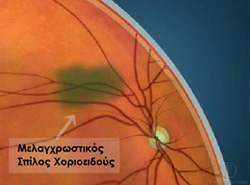It is the most widespread intraocular tumor in adults.
It is almost always found in one eye and can be located in the choroid, ciliary body or iris.
It can be a primary condition, or a transformation of pigmented nevus.
It is quite often a random finding in an eye examination, thus confirming the significance of periodic routine tests as they can prevent visual- or even life threatening conditions.
 Finding such a nevus requires imaging and monitoring at regular intervals for any changes in size or texture.
Finding such a nevus requires imaging and monitoring at regular intervals for any changes in size or texture.
Melanoma of the choroid is usually asymptomatic but may give symptoms such as reduction or loss of vision, metamorphopsia (distortion of objects) due to the attack on the retina in the macula lutea region, etc.
The suspicion of malignant melanoma warrants further investigations, such as fluoroangiography and ultrasound of the eye.
The prognosis of the melanoma is mainly dependent on the size and location of the tumor. Small tumors that are detected in one area, are usually curable, and there is a high probability of visual preservation.
But the treatment of patients with larger tumors in multiple locations is more difficult; this may include radiotherapy, chemotherapy, immunotherapy (administration of vaccine to induce the body's immune response against tumors), Laser photocoagulation, even the removal of the eye.
Because melanomas are highly malignant tumors, the patient should be closely monitored for the risk of metastasis, particularly in the liver.
 German
German Ελληνικά
Ελληνικά